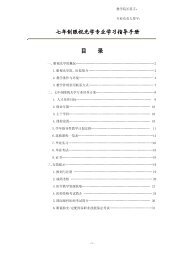Refractive Lens Surgery
Refractive Lens Surgery
Refractive Lens Surgery
Create successful ePaper yourself
Turn your PDF publications into a flip-book with our unique Google optimized e-Paper software.
216 R.Braga-Mele · T. Devine · M. Packer<br />
states (100% power, foot pedal fully depressed<br />
for 3 minutes) showed no significant<br />
temperature rise. The maximum temperature<br />
was 33.6∞C in the non-occluded state and<br />
41.8∞C in the occluded state.<br />
In all instances, the corneal wound remained<br />
clear. No wound burn or contracture<br />
was noted. The results revealed that bare-needle<br />
phacoemulsification did not result in clinically<br />
significant temperature rises in phacoburst<br />
mode using 80-millisecond burstwidth<br />
intervals of up to 100% power and 160millisecond<br />
burst-width intervals of up to 70%<br />
power. The demonstrated temperature rises<br />
were under clinically unusual parameters.<br />
Phacoemulsification with a sleeveless needle<br />
through a small stab incision can be safely performed<br />
using conventional phacoburst-mode<br />
settings within certain parameters on the Millennium.<br />
23.7 Additional Research<br />
Other recent wound temperature studies<br />
have focused on the newer power modulations,<br />
including hyperpulse and fixed burst.<br />
Settings of 8 pps with a 30% duty cycle; 120<br />
pps with a 50% duty cycle; and fixed burst of<br />
4 milliseconds on, 4 milliseconds off; 6 milliseconds<br />
on, 12 milliseconds off; and 6 milliseconds<br />
on, 24 milliseconds off, were all tested<br />
with a thermocoupler in the wound as<br />
described previously. There were no significant<br />
temperature rises.<br />
Investigators in a clinical study [6] used a<br />
quick-chop technique on cataracts ranging<br />
from 2 to 4+ nuclear sclerosis. They performed<br />
phacoemulsification using a burstmode<br />
setting of 100-millisecond burst-width<br />
intervals with a bare, sleeveless MicroFlow<br />
30° bevel, 20-gauge phacoemulsification needle<br />
(Bausch & Lomb, Rochester) through a<br />
1.4-mm incision made with a diamond blade.<br />
This wound size allows the 1.1-mm phacoemulsification<br />
tip to enter the eye without<br />
any strain on the wound, and a small amount<br />
of egressing fluid cools the wound without<br />
compromising the chamber. The investigators<br />
also employed irrigation through a 1.4mm<br />
side-port incision using a 19-gauge irrigating<br />
chopper with two side irrigating ports.<br />
Using an irrigating chopper with two side irrigating<br />
ports rather that one main central<br />
port may improve the fluidics within the anterior<br />
chamber, thus allowing currents to direct<br />
nuclear fragments to the phacoemulsification<br />
tip, whereas a direct stream of fluid<br />
could repel fragments.<br />
In this study, vacuum levels were set on the<br />
Millennium using Venturi mode to vary between<br />
165 and 325 mmHg using dual-linear<br />
technology, and the bottle height was set between<br />
115 and 125 cm. The ability to vary the<br />
vacuum during bimanual phacoemulsification<br />
allows the surgeon the control necessary<br />
to titrate the vacuum level according to the<br />
fluidics and thereby minimize anterior chamber<br />
instability. For instance, one could use<br />
high vacuum when the tip is fully occluded<br />
and hold is necessary in order to ensure an efficient<br />
chop technique. However, once occlusion<br />
is broken, the surgeon may lower the<br />
vacuum to a level that produces the level of<br />
flow and followability desired for efficient removal<br />
of the segment. Under the parameters<br />
and technique described earlier, phacoemulsification<br />
has been performed safely and effectively<br />
by means of a bimanual sleeveless<br />
method with no trauma or burns to the<br />
wounds. Absolute phacoemulsification times<br />
ranged from 2 to 4 seconds in these cases, and<br />
the average case time from skin to skin was<br />
approximately 2 minutes longer than with<br />
conventional phacoemulsification techniques.<br />
The wounds were clear on the first<br />
postoperative day with negligible corneal<br />
edema.



